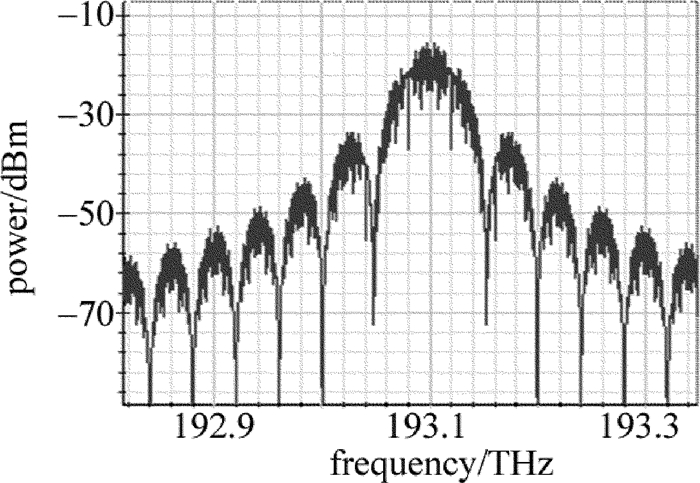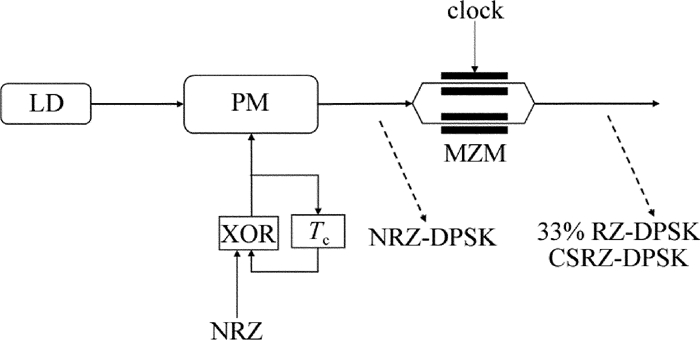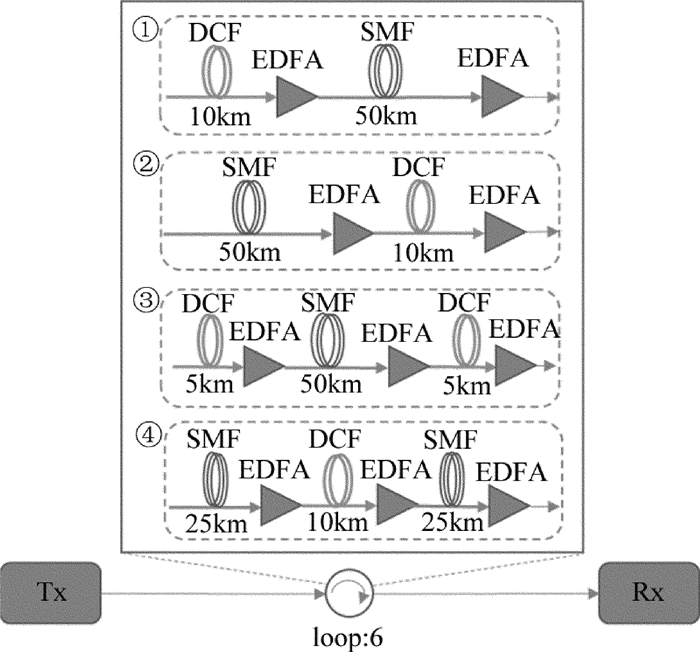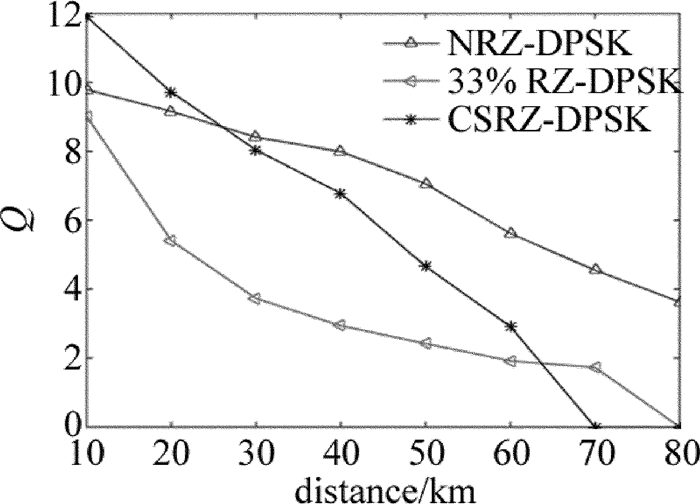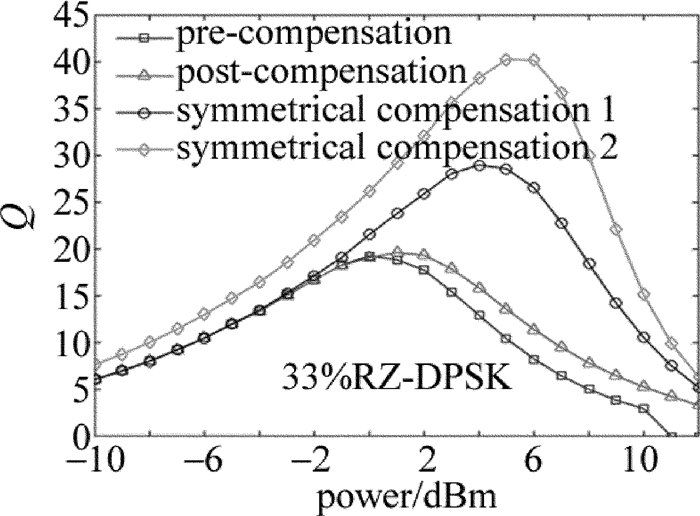HTML
-
随着人类社会的不断进步,21世纪以来,互联网技术行业蓬勃发展,特别是近些年微博、微信、自媒体的出现,使得通信中需要传输的信息量成倍的增加。光纤通信以自身传输速度快并且稳定,适合长距离传输的优势在如今的通信中占主导地位。
限制光纤传输性能的因素主要有光纤的色散[1-5]和光纤的非线性效应[6-7]。对于光纤的色散可以用色散补偿技术来解决,像预啁啾补偿法[8]、光纤光栅补偿技术[9-10]和色散补偿光纤(dispersion compensation fiber, DCF)技术等[11]。
另外,近些年,对光的新型调制格式[12-14]的研究越来越多,有的通过码型的改变来改善传输性能[15],有的可以抑制光纤的非线性效应[16],高阶的调制格式[17]可以增加光纤的传输速率。
本文中就光差分相移键控(differential phase shift keying,DPSK)调制格式的色散补偿光纤的补偿方案进行了讨论。仿真了非归零码-差分相移键控(non-return to zero code differential phase shift keying,NRZ-DPSK)、33%归零码-差分相移键控(33% return zero code differential phase shift keying,33%RZ-DPSK)和载波抑制归零码-差分相移键控(carrier suppressed to zero code differential phase shift keying,CSRZ-DPSK)这3种DPSK信号的DCF色散补偿方案,并作了对比。
-
根据光脉冲在单模光纤内传输的非线性薛定谔方程[18],若不考虑单模光纤的损耗(即α=0):
式中,A为脉冲包络的慢变振幅,z是光脉冲传输的距离,α是衰减系数,γ是非线性参量,T是随脉冲以群速度移动的参考系中的时间,β2是群速度色散系数,γ|A|2A项是光纤的非线性效应。群速度色散系数β2与色散系数D的关系如下:
式中,D是色散系数,c是光速,λ是波长。
利用下式归一化振幅:
式中,P0是入射脉冲的峰值功率,U是归一化振幅,τ是T对初始脉冲宽度T0的归一化时间。将(3)式代入(1)式得:
式中,Ld=T02/|β2|为色散长度, LNL=1/(γP0)为非线性长度。
令(1)式中的γ=0,即不考虑传输中非线性效应, 再利用(3)式归一化振幅得:
对(5)式进行傅里叶变换得:
式中,${\tilde U}$是U的傅里叶变换,ω是角频率。其解为:
那么,有:
最终光纤的色散效应会使信号脉冲展宽。而色散补偿技术利用了上式的线性特性。
DCF色散补偿技术有以下方式:前补偿、后补偿和对称补偿。对于由两段光纤组成的色散补偿方式,色散表达式为:
式中, Lm=L1+L2是光脉冲信号传输的距离,β21和β22分别为第1段光纤的群速度色散系数和第2段光纤的群速度色散系数;L1和L2分别为第1段光纤的长度和第2段光纤的长度。显然,色散补偿就是让接收的光脉冲与发射的光脉冲一致,即U(Lm, T)=U(0, T),所以色散补偿的条件为:
代入(2)式可得:
式中,D1和D2分别是第1段光纤的色散系数和第2段光纤的色散系数。
-
对于光纤通信中的新型调制格式,频域特性分析对于信号质量的分析有关键作用。
光纤通信中的NRZ-DPSK信号、占空比为33%的RZ-DPSK信号以及CSRZ-DPSK信号的频谱图分别如图 1、图 2与图 3所示。
由图 1与图 2可以看出,40Gbit/s的NRZ-DPSK的频谱主瓣宽度大约是80GHz,而同样传输速率的33%RZ-DPSK的频谱主瓣宽度大约是240GHz。显然后者的频谱宽度更宽,大约是前者的3倍。这是由于33%RZ-DPSK信号时域上的脉冲宽度比NRZ-DPSK信号更窄,所以它在频域上的频谱宽度更宽。CSRZ-DPSK的占空比是66%,介于NRZ-DPSK与33%RZ-DPSK之间,所以其频谱宽度也介于它们之间,如图 3所示。
对于非线性效应来说,NRZ-DPSK信号的能量最大,受非线性影响较严重,因此不适合长距离传输;33%RZ-DPSK信号能量最小,受非线性影响较小,但其受色度色散(chromatic dispersion,CD)和偏振模色散(polarization mode dispersion,PMD)的影响较大;CSRZ-DPSK信号的CD和PMD的影响较小,可有效抑制码间干扰,由于其占空比为66%(小于NRZ-DPSK的100%),故其非线性效应比NRZ-DPSK信号小。
-
在基于DCF的光纤DPSK色散补偿系统仿真中,采用以下4种方案:前补偿、后补偿、对称补偿1和对称补偿2。
NRZ-DPSK, 33%RZ-DPSK和CSRZ-DPSK这3种调制格式的产生原理示意图如图 4所示。激光二极管(laser diode,LD)产生连续光信号,在相位调制器(phase modulator,PM)上进行光调制,由NRZ绝对码与延迟一个周期Tc的反馈信号相异或(exclusive OR,XOR)产生的相对码进行数据加载,这个相位调制器可以采用双驱动马赫-曾德尔调制器[19](Mach-Zehnder modulator,MZM)。连续光信号经过相位调制器调制后,产生NRZ-DPSK信号,然后经过一个MZM进行信号幅度切割产生33%RZ-DPSK或CSRZ-DPSK,具体产生哪种信号是通过修改时钟信号以及MZM的偏置电压来控制[20-21]。
色散补偿系统的仿真模型如图 5所示。Tx是发射端,用于产生NRZ-DPSK, 33%RZ-DPSK和CSRZ-DPSK 3种调制格式的光信号;Rx是接收端,负责光信号的解调和分析信号的误比特率和Q值。中间是一个循环结构,其中有单模光纤(single mode fiber,SMF),色散补偿光纤DCF和掺铒光纤放大器(erbium doped fiber amplifier,EDFA)。系统仿真包括4种补偿方案:前补偿(即DCF+EDFA+SMF+EDFA),后补偿(即SMF+EDFA+DCF+EDFA),对称补偿1(即DCF+EDFA+SMF+EDFA+DCF+EDFA),对称补偿2(即SMF+EDFA+DCF+EDFA+SMF+EDFA),在图 5中分别标为①,②,③,④。
整个系统的传输速率为Rb=40Gbit/s,伪随机序列长度为128bits,每bit采样32次,激光器光源的频率是193.1THz。从发射端到接收端的总传输距离为360km,4种方案对应的SMF的长度与DCF的长度如图 5所示。接收端用眼图分析仪分析各个信号的Q值与误比特率。另外,SMF的参量有:衰减系数为0.2dB/km,色散系数D=16.75ps/nm/km,色散斜率为0.075ps/nm2/km,偏振模色散群延迟为0.2ps/km,有效纤芯面积为80μm2。DCF的参量有:衰减系数为0.5dB/km,色散系数D=-83.75ps/nm/km,色散斜率为-0.3ps/nm2/km,偏振模色散群延迟为0.2ps/km,有效纤芯面积为22μm2。EDFA的增益根据需要为10dB或5dB或2.5dB。
-
系统仿真了在只考虑色散的情况下NRZ-DPSK、33%RZ-DPSK和CSRZ-DPSK信号在经过10km到80km的SMF后的Q值,由图 6可以看出3种不同码型信号的色散容忍度。其中,NRZ-DPSK信号的Q值在20km后最佳且平坦,抗色散能力强,色散容忍度大;33%RZ-DPSK信号随距离10km到30km的增加而Q值急剧下降,表现出最低的色散容忍度;而CSRZ-DPSK信号的Q值在25km~65km之间介于NRZ-DPSK和33%RZ-DPSK信号之内,表现出色散容忍度介于NRZ-DPSK信号与33%RZ-DPSK信号之内。
NRZ-DPSK的Q值关于功率的折线图如图 7所示,包括NRZ-DPSK调制格式的前补偿、后补偿、对称补偿1和对称补偿2共4种方案。由图可知,在-10dBm到-6dBm之间,前补偿、后补偿与对称补偿1的Q值几乎一致。从-3dBm开始前3种方案的Q值差距逐渐增大。其中,前补偿和后补偿的Q值从输入功率从-10dBm~-3dBm的变化过程中增加后逐渐减小。在-4dBm ~ 10dBm变化过程中后补偿的Q值略大于前补偿的Q值,对称补偿1大于后补偿的Q值。另外,仿真结果表明,对称补偿2的补偿效果最好,从-10dBm开始,其Q值就领先于前补偿、后补偿和对称补偿1的Q值,最佳的Q值在功率等于2dBm时达到22.3左右,然后逐渐下降。
33%RZ-DPSK的Q值随功率的变化关系如图 8所示。前补偿、后补偿和对称补偿1这3种方案在-10dBm~-1dBm之间的Q值几乎一致,但前补偿与后补偿只增加到1dBm,然后逐渐下降,而对称补偿1和对称补偿2则增加到5dBm后快速下降。在2dBm~12dBm区间,对称补偿1明显优于前补偿和后补偿两种方案。对称补偿2的方案在-10dBm~12dBm之间的Q值对比其余3种方案有明显优势。与NRZ-DPSK不同的是,最佳的Q值是在功率约等于5dBm时。
CSRZ-DPSK的4种补偿方案的Q值随功率变化的折线图如图 9所示。在CSRZ-DPSK的调制格式下,对称补偿2方案具有最佳补偿效果,Q值可达到42左右。在输入功率低于-6dBm时,前补偿与后补偿方案几乎一致;从-6dBm~-1dBm时,前补偿优于后补偿;从-2dBm~10dBm时,对称补偿1优于前补偿与后补偿。同样地,对称补偿2的方案总体上有明显优势。
图 10表示在3种调制格式最佳的功率和补偿方案的情况下,Q值随距离的变化。其中NRZ-DPSK,33%RZ-DPSK,CSRZ-DPSK 3种调制格式的输入功率选择3dBm,补偿方案选择对称补偿2方案,距离从300km~840km,每隔60km仿真一次。由图可以看出,NRZ-DPSK的效果是3种调制格式中最差的;在300km~360km左右的一段距离中,CSRZ-DPSK的Q值高于另两种调制格式;在360km~840km左右的距离中,33%RZ-DPSK的补偿效果最佳。
3.1. 系统结构和参量
3.2. 系统仿真分析
-
本文中首先介绍了色散补偿的原理,分析了3种调制格式信号的频谱特性,然后仿真了3种码型的色散容忍度情况,最后分别仿真了3种调制格式在考虑光纤的非线性效应下的色散补偿方案,并用Q值来评估传输性能。结果表明:NRZ-DPSK, CSRZ-DPSK与33%RZ-DPSK信号在对称补偿2方案中有最好的色散补偿效果;并且当距离在300km~360km时,CSRZ-DPSK的补偿效果优于33%RZ-DPSK;在360km~840km时,33%RZ-DPSK优于CSRZ-DPSK。

 Map
Map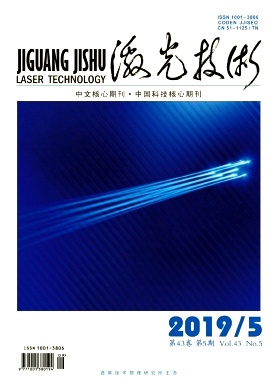




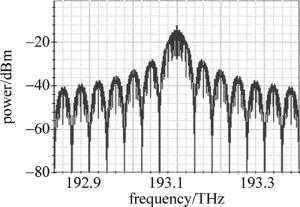
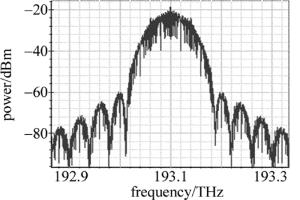
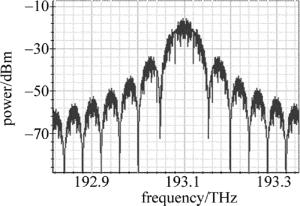
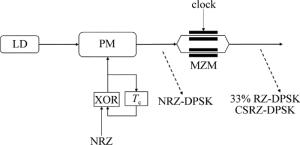

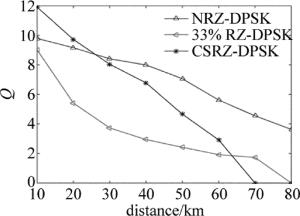

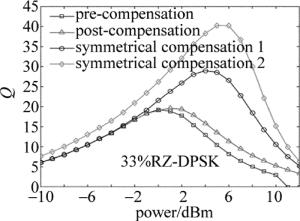
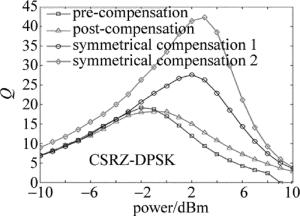

 DownLoad:
DownLoad:

